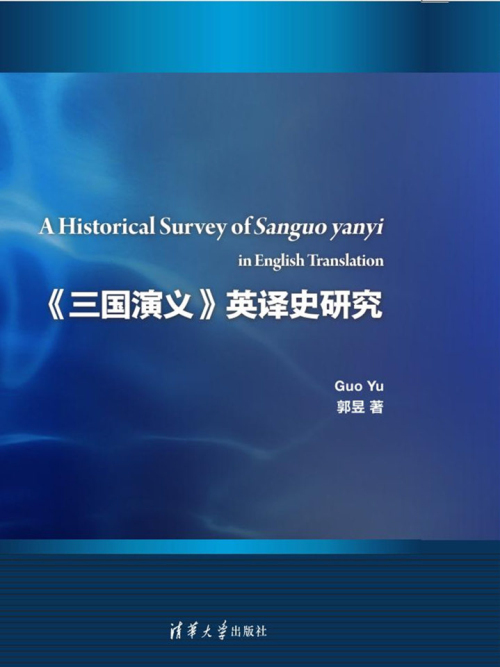《<三國演義>英譯史研究》是2017年清華大學出版社出版的圖書,作者是郭昱。
基本介紹
- 中文名:《三國演義》英譯史研究
- 作者:郭昱
- 出版時間:2017年12月
- 出版社:清華大學出版社
- ISBN:9787302460183
- 定價:78 元
內容簡介,圖書目錄,
內容簡介
本書對19世紀以來的《三國演義》的英譯歷程做了全面深入的描述性研究,把這部經典名著近兩百年的英譯史劃分為三個時期,描述了各個時期翻譯活動的主要特徵,揭示了該小說在英語世界翻譯和傳播的歷史趨勢。本書重視史料和語料相結合:一方面,在圍繞譯本產生和傳播的社會文化背景層面著墨甚多,並非用當今讀者的眼光和標準去衡量上百年前的譯本,而是注重對翻譯活動的歷史性考察;另一方面,不止於抽象的理論探討,而是援引確鑿的譯例對譯本特徵進行微觀層面的具體分析。本書可以作為同領域後來研究者的可靠分析依據。
圖書目錄
Foreword Ⅰ
Acknowledgements Ⅴ
Preface
Chapter One Introduction 1
1.1 Purpose of the book 5
1.2 Scope of the study of translation history 9
1.3 Structure of the book 13
Chapter Two The Translation and Review of SGYY in English 15
2.1 A brief introduction to the Chinese novel SGYY 15
2.2 Sinologists’ comments on the popularity of SGYY 18
2.3 The translation history of SGYY into English 20
2.3.1 Data collection 20
2.3.2 A brief introduction to the English translations 21
2.3.3 Periodization of the history 37
2.4 The review history of SGYY in the English language 39
2.4.1 Data collection 40
2.4.2 A brief introduction to the English reviews 40
Chapter Three The Early Period (1820–1924): Expatriates’ Endeavors 51
3.1 Other identities of translators 56
3.1.1 Identities of foreigners in China during the nineteenth and early twentieth centuries 56
3.1.2 Identities and perspectives of translators 57
3.2 Translation purpose and translation object 63
3.2.1 Influence of Chinese culture on the choice of the translator 65
3.2.2 Sinologists’ views on the novel as a literary form 66
3.2.3 Translation as leisure-time reading material 69
3.2.4 Translation as language learning material 72
3.2.5 Translation as research 75
3.3 Translation strategies 77
3.3.1 Translation strategies 77
3.3.2 Reasons for the translation strategies adopted 80
3.4 The journal as a unique outlet for translations and reviews 84
3.5 Conclusion 89
Chapter FourThe Middle Period (1925–1975): An Age of Diversity 91
4.1 Three translations of the same episode 94
4.1.1 Z. Q. Parker’s translation 94
4.1.2 Yang Xianyi and Gladys Yang’s translation 95
4.1.3 Cheung Yik-man’s translation 98
4.2 Charles Henry Brewitt-Taylor and his Romance of the Three Kingdoms 100
4.2.1 Charles Henry Brewitt-Taylor 100
4.2.2 The reason why Brewitt-Taylor undertook the translation 101
4.2.3 Target reader 107
4.2.4 Translation strategies 111
4.2.5 Publisher’s role in the formation of the translation 119
4.2.6 Mistranslations 122
4.2.7 Reception of the translation by Brewitt-Taylor’s contemporaries 131
4.2.8 Influence of Brewitt-Taylor’s translation 133
4.3 Conclusion 137
Chapter FiveThe Late Period (1976– ): The Academic Turn 139
5.1 Translation purpose and target audience 141
5.2 Production under ideal circumstances 142
5.3 The academic turn and the translator’s subjectivity 143
5.3.1 The translator as a scholar 144
5.3.2 The translator’s subjectivity and translation strategies 148
5.4 Patronage 158
5.5 Reception of Roberts’s translations 159
5.5.1 The 1976 edition 159
5.5.2 The 1991 edition 161
5.5.3 The 1999 edition 164
5.6 Mistranslations in Moss Roberts’s versions 164
5.7 Conclusion 166
Chapter Six Conclusion 169
6.1 Historical tendencies of the English translation of SGYY 171
6.1.1 Transformation of the subject of translation activities 171
6.1.2 Transformation of the translation purpose and readership 172
6.1.3 Transformation of the translator’s cultural orientation 173
6.2 Retranslation and its causality 175
Bibliography 179 Appendices 193
Appendix A: A Catalogue of English Translations of SGYY (in chronological order) 193
Appendix B: A Catalogue of English Reviews of SGYY (in chronological order) 196
Appendix C: An Interview with Professor Moss Roberts 198
List of Tables 201

